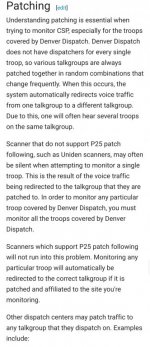Hello all,
I have a question regarding monitoring the CSP troop 2C (TG 2524 -Troop 2C Dispatch - Baca, Bent, Cheyenne, Crowley, Kiowa, E. Las Animas, Otero, Prowers).
I have noticed that at times I hear a lot of their dispatch and traffic, other times I can go for several hours without hearing a single thing from that TG. Unfortunately, I am brand new to scanning and am trying my best to understand things from the ground up.
What I do know, or think I know so far is this. I have to use my local site, which is the best signal, and also the site in neighboring La Junta to hear the full amount of radio transmissions they broadcast. I assume if I cut off the La Junta site, I would be cutting off the transmissions I've seen that site being used for, as they wouldn't just use my local site, if that other site was removed leaving just my local site being monitored. That's upsetting but I guess that's the way it works.
So, to my main point. I've attached something that I've found while researching why I hear them so often at times, and then dead silence for long periods of a time, before they randomly start back up transmissions, in the middle of something they are currently handling. Note, at first I thought maybe it was simply there was no radio traffic occurring, but I find this to be false, in my opinion. And yes I know this uses Denver as the example, although my monitored dispatch would be Pueblo. I do believe that this would also be the same in Pueblos dispatch area, as they dispatch for many TG's/ troops.
Anyone have any knowledge why it goes silent for a long period of time before starting back up again? And have any insight on how to remedy it, possibly? I'm very confused as to what the example I've attached means, or what's going on. I have noticed that sometimes another troops TG was all of a sudden talking on my areas TG. Not sure why this happened either, like it was their TG I was monitoring.
Anyways, if anyone has any insight and helpful advice, tips, or so on.. I would greatly appreciate the help! Thank you!
I have a question regarding monitoring the CSP troop 2C (TG 2524 -Troop 2C Dispatch - Baca, Bent, Cheyenne, Crowley, Kiowa, E. Las Animas, Otero, Prowers).
I have noticed that at times I hear a lot of their dispatch and traffic, other times I can go for several hours without hearing a single thing from that TG. Unfortunately, I am brand new to scanning and am trying my best to understand things from the ground up.
What I do know, or think I know so far is this. I have to use my local site, which is the best signal, and also the site in neighboring La Junta to hear the full amount of radio transmissions they broadcast. I assume if I cut off the La Junta site, I would be cutting off the transmissions I've seen that site being used for, as they wouldn't just use my local site, if that other site was removed leaving just my local site being monitored. That's upsetting but I guess that's the way it works.
So, to my main point. I've attached something that I've found while researching why I hear them so often at times, and then dead silence for long periods of a time, before they randomly start back up transmissions, in the middle of something they are currently handling. Note, at first I thought maybe it was simply there was no radio traffic occurring, but I find this to be false, in my opinion. And yes I know this uses Denver as the example, although my monitored dispatch would be Pueblo. I do believe that this would also be the same in Pueblos dispatch area, as they dispatch for many TG's/ troops.
Anyone have any knowledge why it goes silent for a long period of time before starting back up again? And have any insight on how to remedy it, possibly? I'm very confused as to what the example I've attached means, or what's going on. I have noticed that sometimes another troops TG was all of a sudden talking on my areas TG. Not sure why this happened either, like it was their TG I was monitoring.
Anyways, if anyone has any insight and helpful advice, tips, or so on.. I would greatly appreciate the help! Thank you!


